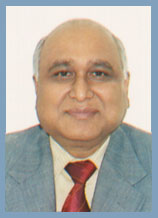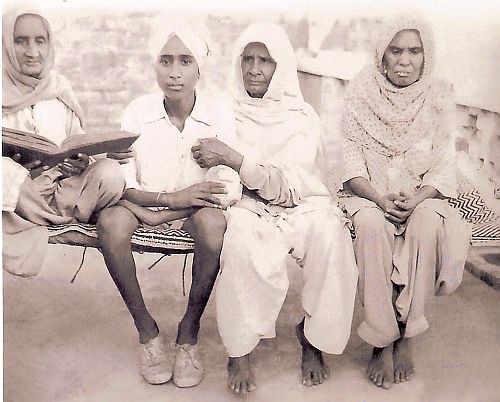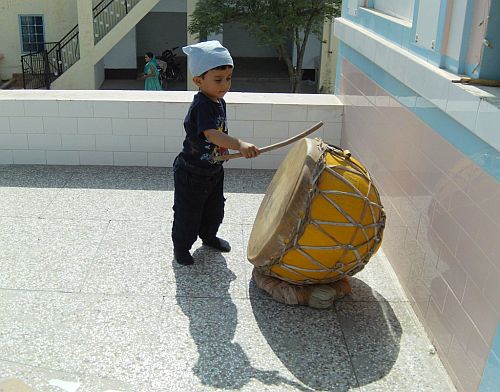My Village, my Kith and Kin, and Festival of Lohri
Category:

Bal Anand was born in 1943, in a village about 20 km south of Ludhiana, in a family of saint-scholars who practised Ayurveda. Graduated from DAV College, Jalandhar, and did Master in English Literature from Govt. College, Ludhiana. After a stint for a few years as lecturer, joined the Indian Foreign Service. Served in nine different countries and retired as India's High commissioner to New Zealand. Now reading, reflecting and writing in nest in Greater Noida.
The people of my generation – now on the threshold of striking six score and ten years– in the Indian Punjab remain deeply fond of digging into our rural roots.
Interestingly, by tradition, the Sikh leaders have often preferred to make the name of their village as their surname- Kairon, Badal, Barnala, Tohra, etc. The ‘re-awakening’ of the long asleep memories of the Pind (village) often arouses complex and strange feelings-full of awe, romance, mystery, wonder and melancholy too. The village, at times, could be quite another planet, figuratively ‘electric-light-years’ away in the past. The overall life itself could be several quantum jumps different for many. The media these days carries tons of real life accounts of the NRIs who are dead set in their ripe old age to do something for their ancestral Pind, the land-space where they had been playing and running about without Langoti (under wear) even when they were not so innocent children!

L to R: Great Grand maternal aunt (holding the book), Bal Anand, Naanee, Grandmother. Sitting on a charpai.
Roof of our two-room rented home in Ahmedgarh. c. 1954
I do possess a treasure of touching memories of the very early pre-school years spent in Jandali, my maternal village - my Naanke. But it is my Daadke (paternal village) which has legitimately exercised its stranglehold on my soul. It does not matter that I had left my Pind behind on May 7, 1951 to live and study 10 Km away in a neighbouring town, called simply Mandi, implying primarily a grain market. It happened six months before my eighth birth day. In those good old days, ‘the date of happy birth day' was often ‘discovered' only at the time of completion of the form of the Punjab University for appearing in the matriculation examination! But...could anyone ever imagine that 63 years after Independence, the Government of India will be fighting a big battle about the exact date of birth of the Chief of Army Staff of India!
The many journeys of the 15 Km distance from my paternal village, Falaund Kalan near Maler Kotla, called Shahar, to my maternal village Jandali on the Sirhind canal used to be performed on foot, with the first four Km through the slipping sandy patch. Mostly undertaken in the morning hours, the journey had its poetic and epochal moments. I remember Sarwan's Khuhi, the little well, in the sandy path. It was, according to the popular legend, dug for travellers by the family owning that piece of land to honour the memory of their young son who was killed at that spot by a vengeful camel.
The petty town of Malaudh with sweets and toys shops impressed the little child in me\; a patch of pucca (macadamized) road and a brick building of the dispensary proclaimed that it was Angrezi Ilaqa (British territory). I remember the villages on the way - Madanipur, Bawarpur, Chomon, Nizampur.
The crossing of the open iron girders bridge - called pulli - of the canal with the fast flowing deep water below, just before my Naanke village, would fill my heart with fear...what if I slipped! The last of such journeys I remember was some time in 1949 when my angry father forcibly snatched me from my maternal uncle while I was persisting on accompanying my Naanee (mother's mother).
She had, perhaps, said in a choking voice, "son, now you must attend school...I shall be regularly coming to meet you." Having lost mother when I was less than three year old, my Naanee had been more than a mother to me. A lady who looked wise and acted like the leader of the house, had been showering so much affection and so many presents on me. She died when I was in the final year of B.A.
My Daadke Falaund Kalan is still separate in official administration from adjacent Falaund Khurd, has nothing to distinguish itself except the Samadhi (abode of eternal meditation) of Baba Gajjan Shah Ji (1736-1840), the patriarch of our clan proclaiming to belong to Diwana sect of the eminent saintly orders of Punjab.
Vaid (local doctor) Bhushan Param Sant Parmatma Nand Ji (died October 19, 1947), my most scholarly great-grandfather, wrote Gajjan Bilas (biography) in Brij Bhasha and traditional classical style to put the spiritual saga of the family in its poetic and historical perspective. Parmatma Nand Ji had been running a virtual one-person Gurukul - an in-house university -where rigorous instructions in various branches of traditional education - Ayurved above all- were imparted along with free food and shelter.
My father, Vaid Rattan Haridial Nand Ji (1920-1978) alias Haridial Singh (read about him in Pitaji - A Unschooled Learned Man) must have worked hard day and night to become the most favourite disciple of the Guru Pitamah. The elders in the family used to tell me that I was the golden apple of the eyes of the two great grandfathers and their childless widowed sister, not to speak of so many other elders around who were also so kind to me.
It has been the annual three day fair of the festival of Lohri which has made Falaund indeed a pindan vicho pind (special one among the villages). As per the Sakhi - chapter of narration - in Gajjan Bilas, it was "in Samvat 1884 (1827 CE), Magh tithi trosadi (the thirteenth day of Magh) that Baba Ji ordained all relations and large circle of friends and followers to visit Falaund every year for a stay of three nights to celebrate the Maghi Mela". The Fair of Lohri has been ever since a ‘must visit' festivity for all those related with the village. I have the fondest memories of the closer and distant relations as well as old friends of childhood, not speak the transformation over the years of the fair itself. The popular essay of ‘A Visit to a Village Fair', in the various classes of school used to bring before my eyes all the real images of the fair which literally belongs to my clan-and, in a subtle sense, has spanned all these years of my life!
Our original two-part family home was made of mud walls. One portion called Swaat with exquisite Sandooki -wood boards-ceiling - lasted about seventeen years after the family had moved out to live in town. It was in 1967 that I had spent the night in the premises of this house. It was the occasion of the Bhog of my grandfather.
I got the boundary wall made in 2007 around this 1,000 square yard piece of land - once the cosiest nest of my most beloved ones. My Pehli-dooji (elementary school) class fellow, Jang Singh has been my soul mate link to the time and life in the village. A progressive farmer for more than a decade, he had retired as a senior science teacher. His letters in chaste and calligraphic Punjabi made such an instructive and delightful reading during my long years in distant lands saat samunder paar (across the seven seas)! It was after full forty years that I that I stayed for a night in the village in April 2008 at Jang Singh's new house-furnished with all the modern facilities, including the toilet with an efficient flush system!
I have many a heart-piercing memories of the years of life in the village, long, long ago. In early 1949, Mohan was dead one night after a brief illness\; his younger brother Manohar survived, but both his eyes were gone! It happened just twenty child-steps from my home. Sheetla Mata (small pox) had entered Mohan-Manohar's home. Whenever I visit the village, I make sure to speak to Manohar ... of the days when we had played together, and he could see, and run so fast!
Why do so many people - ordinary, rich, or powerful too - wish and long to be cremated /buried in the native village, their place of birth? Perhaps, an instinctive urge to complete the cycle of life-returning to the soil from which one had sprung!
Gone are, however, the times when people spent their entire lives at the same place, doing the same work which generations in the family before them were doing. My scholarly school teacher Ashni Kumar had quoted Hindi poet Sohan Lal Diwedi, "Bharatmata Gram Vasini (mother India resides in her villages." Gandhi Ji was always extolling the virtues of the simple and self-sustaining villages. In the 21st century India - nay, the world over - urbanization has been accepted as salvation of life, and the march of urban way of life seems all set to prevail sooner than anticipated.
During s short training course in the Indian Institute of Mass Communications in 1972, we, a group of Indian Foreign Service trainees, were asked by the course Director if anyone in the group had actually spent a night in a village without electricity and the basic toilet facilities. I was the only one to raise my right hand. I remembered all those three thousand nights, including those of the summer when the leaves of big banyan and other trees became silent and motionless, while we looked at the stars - the dhroov Tara, i.e., Pole Star, in particular.
Grandmother would ask me to count names of ten villages / towns with names ending with Pur like Ram Pur, Kan Pur, Saharan Pur, Mullan Pur, Anand Pur ...and then pray, "Hey Puri Ji, Puri Chala (O God of winds, let the breeze be blown)!" And, lo there will be murmur among the leaves!
Having missed the Lohri Fair of my Village in 2010 and 2011, I was determined to make a pilgrimage on the 15th January, 2012 to the consecrated place of the forefathers. I wanted to comply with the 185-year old Hukamnama (moral order) as recorded in the Gajjan Bilas!
Epilogue
To commemorate the memory of my most scholarly grandfather, Param Sant Vaid Bhushan Pramatma Nand Ji, I have instituted, under the aegis of Sant Pramatmanand Academy of Creative Excellence (SPACE) an annual literary award for the distinguished writer of the area.
The first award was given at the Lohri Fair on January 15, 2015 to Dr Prof S. Tarsem, an eminent scholar and poet of Punjabi who has served as the first visually challenged teacher in a college in Punjab. The Member of the Lok Sabha from the area, Sardar Harinder Singh Khalsa, a dear friend who had resigned from the Indian Foreign Service, in the wake of Operation Blue Star, conferred the award.
Referring to Harinder's joining politics, I was wondering how the Destiny indeed determines the roles we play in life! I shared the story with the audience how the last Maharaja of Patiala Yadvindra Singh's last duty was the same as my own - An Ambassador of India!
The SPACE Award for 2016 was conferred at the Lohri Fair by Prof Dr Jagmohan Singh on Dr Harnek Singh Kaler, a distinguished editor and author in Punjabi. Jagmohan Ji, an eminent former academic of the Punjab Agricultural University, Ludhiana and my class fellow of graduation, is a nephew of Shahid Bhagat Singh. He is one of the most respected person in Punjab as the champion of human rights. Taking different routes in life in free India, he and I have been most steadfast in our friendship and commitment to do something noble for our beloved country.

Front row L to R: Baldev, popularly called Gandhi, because of his skeletal-weak body. Grandson of Bal Anand, Bal Anand, Master Baljit Singh, now in late eighties (I had attended his marriage as a child in 1948).
Back row: Various village residents. Falaund Kalan village 2011.

Bal Anand's New Zealand born grandson, Antariksh, the ninth descendant of Baba Gajjan Shah, striking his harmony at Samadhi. Falaund Kalan village 2011.
The film Udta Punjab has recently revealed the sordid side of the legendary and forward looking Punjab. My good old friends and I continue, in our own humbler ways, rooting in our villages for the roots of the values of decency, creativity and linkages of love!
© Bal Anand 2016
Add new comment